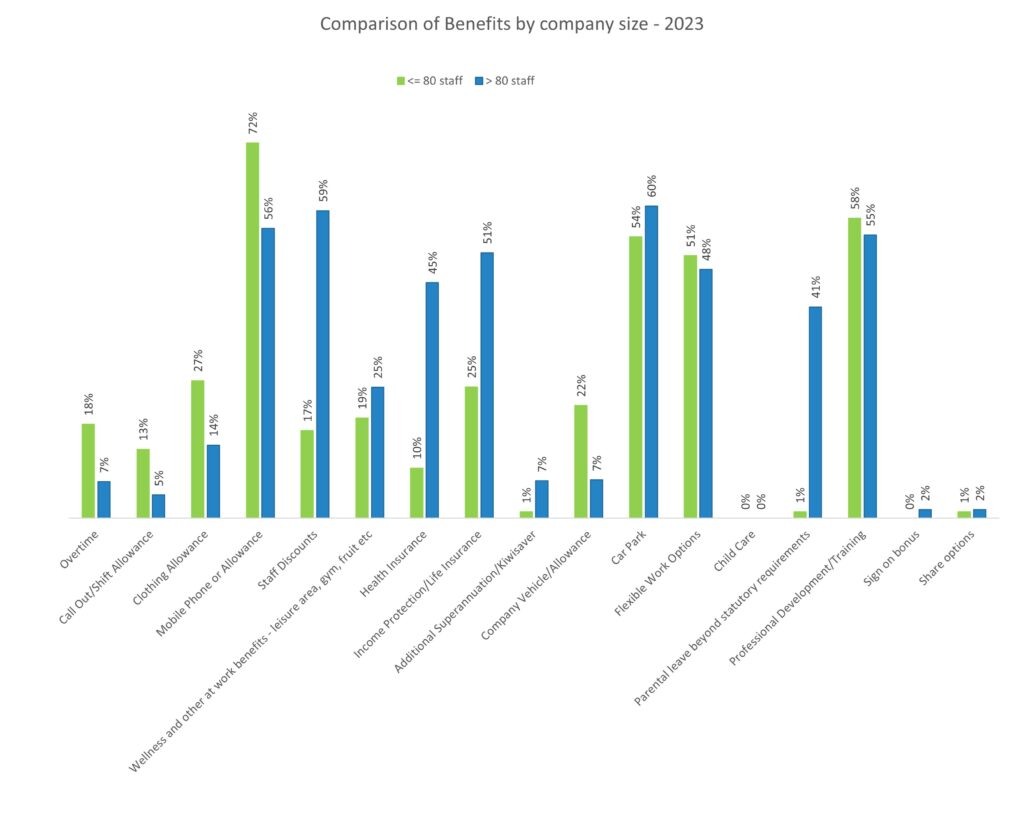Company size matters! – The New Zealand 2023 Industry Salary Survey
The Lawson Williams/NZIFST 2023 Salary Survey results present very clearly – the smaller the company the higher the % of salary increases since 2021 in New Zealand.

In the latest New Zealand Salary Survey, larger companies have managed to mitigate the impact of salary increases more effectively.
At first glance, this might appear to be a risky approach.
It’s important to recognise that offering competitive salaries is crucial in retaining employees. In fact, nearly 50 percent of job searches are primarily motivated by uncompetitive salaries, surpassing factors like limited promotional opportunities and poor management or workplace culture.
How has this been achieved, particularly in an environment of high inflation with pressure on salaries to meet the increased cost of living resulting in employees being more willing to step into the market to obtain better remuneration?
The 2023 Food Industry Salary Survey sheds light on how remuneration packages differ based on a company’s size.
Changes in remuneration benefits offered by all companies between 2021 and 2023 – New Zealand Salary Survey
For all companies regardless of size, there have been significant differences since 2021.

Increase in Professional development and training.
“Enhancing professional and personal development opportunities for employees has emerged as a dual advantage for employers of all sizes in New Zealand since 2021. In the age of Industry 4.0, this shift is not just a choice but is increasingly regarded as a necessity for business survival. If you visited the recent Foodtech/Packtech exhibition you would easily have been confronted with the absolute importance of training all staff to meet the demands of a digital future.
Increase in Wellness, Health, and other Insurance benefits.
“The COVID-19 pandemic has placed a significant emphasis on how compensation and benefits can offer support to employees and their families during times of uncertainty, both within the pandemic’s immediate impact and in the long term. In response, many companies swiftly enhanced their employee benefits packages, with a particular focus on bolstering healthcare coverage and overall wellness support. It’s evident that this trend is poised to remain a top priority for employees and organizations alike.”

Increase in Parental Leave beyond statutory requirements.
New Zealand has made significant strides in enhancing paid parental benefits, with the survey revealing an impressive increase from a previously modest starting point. This shift aligns with international trends that clearly demonstrate the advantages of expanding parental leave provisions. Such policies prove instrumental in attracting and retaining top talent while simultaneously curbing turnover rates. Interestingly, for most companies, these improvements come at a minimal cost, especially when considering the substantial savings resulting from reduced employee turnover. The ultimate outcome is a more engaged, productive, and loyal workforce.
In addition to these benefits, New Zealand employers have also faced mounting pressure to address the 20% retirement savings gap between men and women’s average KiwiSaver balances. Research by NZIER in June 2022 shed light on the substantial financial impact on women who choose to temporarily leave the workforce or work part-time after having children. This choice can potentially lead to a loss of retirement savings ranging from $58,000 to $318,000. Paid parental schemes play a crucial role in mitigating this gender-based disparity, offering a direct solution to this pressing issue.”
Benefit comparisons between small and large companies in NZ Industry – 2023 NZ Industry Salary Survey
Comparing the remuneration benefits based on company size there are some distinct differences.

In New Zealand, the management and affordability of wellness, health, and insurance benefits, as well as extending parental leave beyond statutory requirements, present distinct challenges for small and large businesses.
Larger corporations have an advantage, as they can more readily implement and fund comprehensive health insurance programs, benefiting from economies of scale. Over the past three years, these companies have leveraged existing schemes to enhance the value of benefits for both current and prospective employees.
Additionally, the size of a company plays a crucial role in structurally supporting longer periods of parental leave. This flexibility has enabled larger enterprises to embrace extended parental leave policies, meeting the growing demand for improved provisions. Moreover, it allows them to address the financial implications of parenting, especially for parents (especially women) who may opt for longer parental leave or part-time work while their family is young. This decision can significantly impact their retirement savings.
Conversely, smaller companies have been compelled to increase salaries at a higher rate in New Zealand as a strategy to attract and retain staff. In the face of inflation and workforce shortages, larger corporations have adopted a broader spectrum of benefits, strengthening their overall remuneration packages to remain competitive in the labour market.
The provision of professional development and training has increased as an employee benefit in smaller New Zealand companies.
The Lawson Williams/NZIFST 2023 Industry Salary Survey reports that smaller companies have increased their focus on the development and training of their employees and are now matching larger organisations looking to maximise performance and increase retention and attraction.
It is important however for small companies to realise that in today’s employment market training and development is more often linked by employees to the gaining of “Career Capital”.
The key is for small companies to be aware of the difference between employee training and employee development.
Employee development operates on a long-term horizon, acting as the catalyst for ongoing progress both for individual employees and the overall business. Employee development focuses on refining soft skills such as leadership, attitude, and communication within the workforce.
Employee training serves to enhance the technical competencies of employees, enabling them to expand their knowledge within the scope of their roles and responsibilities. It is a short-term initiative designed to yield quick results.
A holistic approach to training and development allows employees to envision the broader trajectory of their personal growth. Smaller companies can struggle to accommodate the career potential of their employees who are looking for professional development and real career opportunities.
To see Lawson Williams’s latest surveys, please visit our ‘Surveys Page’.
